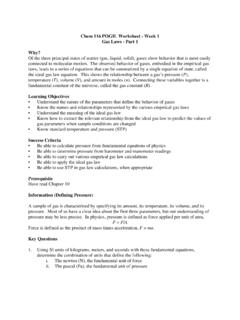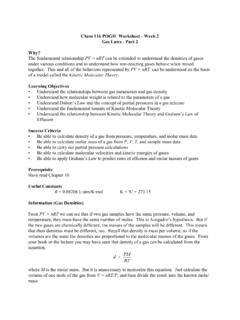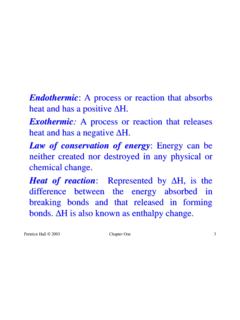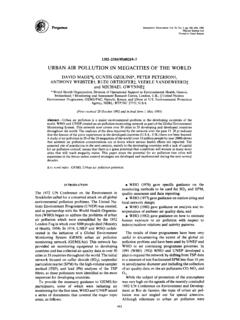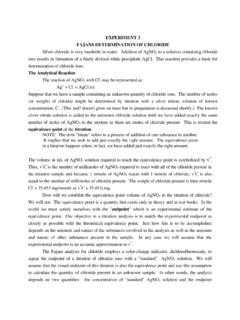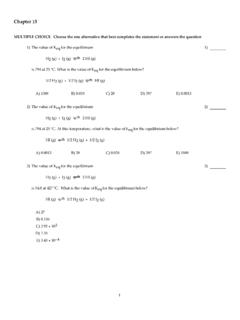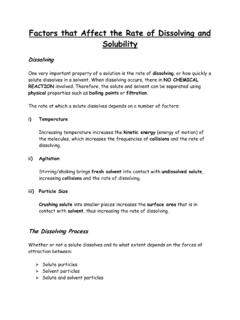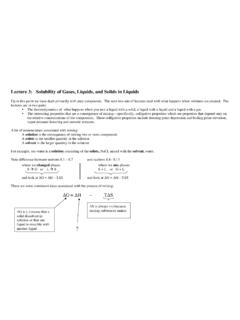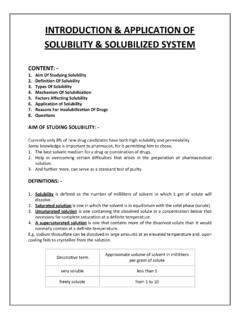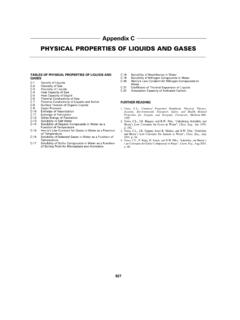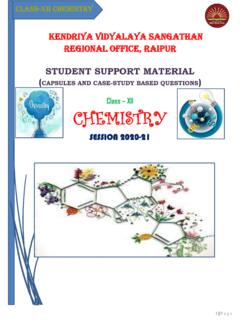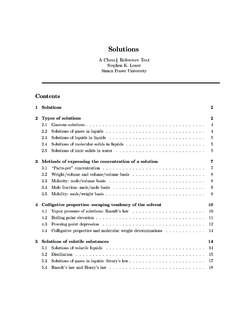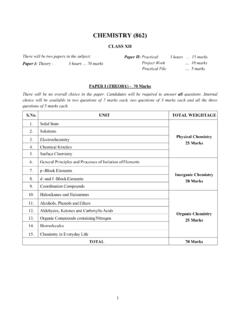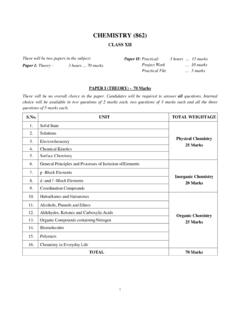Transcription of Chapter 13 Properties of Solutions
1 Chemistry, The Central Science, 10th edition Theodore L. Brown; H. Eugene LeMay, Jr.;. and Bruce E. Bursten Chapter 13. Properties of Solutions Solutions Solutions Solutions are homogeneous mixtures of two or more pure substances. In a solution, the solute is dispersed uniformly throughout the solvent. Solutions Solutions The intermolecular forces between solute and solvent particles must be strong enough to compete with those between solute particles and those between solvent particles. Solutions How Does a Solution Form? As a solution forms, the solvent pulls solute particles apart and surrounds, or solvates, them. Solutions How Does a Solution Form If an ionic salt is soluble in water, it is because the ion- dipole interactions are strong enough to overcome the lattice energy of the salt crystal.
2 Solutions Energy Changes in Solution Simply put, three processes affect the energetics of the process: Separation of solute particles H1( this is always endothermic). Separation of solvent particles H2 ( this too is always endothermic). New interactions between solute and solvent H3 ( this is always exothermic). The overall enthalpy change associated with these three processes : Hsoln = H1 + H2+ H3. Solutions The process solution formation can be either endo or exothermic Hot packs use MgSO4 and cold packs use NH4NO3 and water. Solutions The solvent solute interactions must be strong enough to make H3 comparable in magnitude to H1 + H2. So NaCl will not dissolve in nonpolar liquids as the attraction between the ions and the nonpolar solvent will not compensate for the energies required to separate the ions.
3 Solutions Energy Changes in Solution The enthalpy change of the overall process depends on H for each of these steps. Solutions Why Do Endothermic Processes Occur? Things do not tend to occur spontaneously ( , without outside intervention) unless the energy of the system is lowered. Solutions Why Do Endothermic Processes Occur? Yet we know that in some processes, like the dissolution of NH4NO3 in water, heat is absorbed, not released. Solutions Enthalpy Is Only Part of the Picture The reason is that increasing the disorder or randomness (known as entropy) of a system tends to lower the energy of the system. Solutions Enthalpy Is Only Part of the Picture So even though enthalpy may increase, the overall energy of the system can still decrease if the system becomes more disordered.
4 Solutions The process occurring at a constant temperature in which the randomness in space or the entropy of the system increases tend to occur spontaneously Solutions Student, Beware! Just because a substance disappears when it comes in contact with a solvent, it doesn't mean the substance dissolved. Solutions Student, Beware! Dissolution is a physical change you can get back the original solute by evaporating the solvent. If you can't, the substance didn't dissolve, it reacted. The above example is the reaction of nickel with HCl resulting in the formation of NiCl2 Solutions Types of Solutions Saturated Solvent holds as much solute as is possible at that temperature.
5 Dissolved solute is in dynamic equilibrium with solid solute particles. Solutions Types of Solutions Unsaturated Less than the maximum amount of solute for that temperature is dissolved in the solvent. Solutions Types of Solutions Supersaturated Solvent holds more solute than is normally possible at that temperature. These Solutions are unstable; crystallization can usually be stimulated by adding a seed crystal or scratching the side of the flask. Solutions solubility , saturation and supersaturation As you add more solute to a solution Below saturation At saturation point Beyond saturation Solvent is not yet Solvent is holding Solvent is holding holding the the maximum more solute than it maximum amount amount of solute it is able to at that of solute it can at can at that temperature.
6 That temperature temperature situation is unstable More solute could If you add any more If you add anything still dissolve if solute, it will not to the solution, the you add more, it will dissolve (will fall to excess (beyond mix in the bottom saturation point). precipitate) will crystallize out solubility = often measured in grams of solute per 100. mL of solvent Solutions Factors Affecting solubility Solute Solvent Interaction Chemists use the axiom like dissolves like : Polar substances tend to dissolve in polar solvents. Nonpolar substances tend to dissolve in nonpolar solvents. Solutions The more similar the intermolecular attractions, the more likely one substance is to be soluble in another.
7 Solutions Glucose (which has hydrogen bonding). is very soluble in water, while cyclohexane (which only has dispersion forces) is not. Solutions Vitamin A is soluble in nonpolar compounds (like fats). Vitamin C is soluble in water. Solutions Solutions Gases in Solution In general, the solubility of gases in water increases with increasing mass as the attraction between the gas and the solvent molecule is mainly dispersion forces. Larger molecules have stronger dispersion forces. Solutions Effect of Pressure The solubility of solids and liquids is not affected by pressure. However the solubility of gases is greatly affected by pressure. Solutions Gases in Solution The solubility of a gas in a liquid is directly proportional to its pressure.
8 Solutions Henry's Law Sg Pg Sg = kPg where Sg is the solubility of the gas;. k is the Henry's law constant for that gas in that solvent at that temperature Pg is the partial pressure of the gas above the liquid . Solutions Solutions Calculate the concentration of CO2 in a soft drink that is bottled with a partial pressure of CO2 of atm over the liquid at 25 C. The Henry's law constant for CO2 in water at this temperature is 10 2 mol/L-atm. Page 542. : 2. Solutions Calculate the concentration of CO2 in a soft drink after the bottle is opened and equilibrates at 25 C under a CO2 partial pressure of 10 4 atm. The Henry's law constant for CO2 in water at this temperature is 10 2 mol/L-atm.
9 Solutions Temperature Generally, the solubility of solid solutes in liquid solvents increases with increasing temperature. Solutions Temperature The opposite is true of gases: Carbonated soft drinks are more bubbly if stored in the refrigerator. Warm lakes have less O2 dissolved in them than cool lakes. Solutions How to read a solubility curve 1. How much KCl would be able to dissolve in 100 g of water at 50 C? 2. At 40 C, exactly 64 g of an unknown salt dissolved in 100 g of water. What is the likely identity of the unknown? 3. At what temperature could you fully dissolve 80 g of NaCl in 200 g of water? 4. At 60 C, 30 g of KClO3 are dissolved in 100 g of water.
10 Is the solution undersaturated, saturated or supersaturated? Solutions How would this affect the marine life if the water temperature goes up .. Solutions Ways of Expressing Concentrations of Solutions Solutions There are many ways to express concentration mathematically Weight percent = mass of component per total mass (expressed as a percentage). Mole fraction = moles of component per total moles (expressed as a value between 0 and 1). Molarity = moles of solute per liter of solution Molality = moles of solute per kg of solvent Solutions Mass Percentage mass of A in solution Mass % of A = 100. total mass of solution Solutions Parts per Million and Parts per Billion Parts per Million (ppm).
